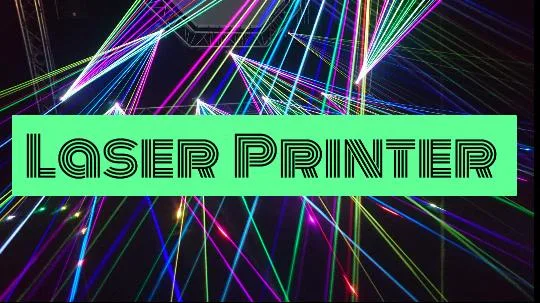Laser Printer

A Laser printer can simply be defined as a computer Printer that has the ability to print high-quality text and graphics on an empty paper, It is similar to that of Xerox technology. However, it does not generate an image by using dots rather it uses light, electricity pressure, and heat. Hence, it is considered as a complex procedure.
For accomplishing this task of printing on plain paper it makes use of certain components discussed below.
(a)Toner Cartridge
The component produces the toner that is needed for creating an image on the paper. Toner is nothing but the powder
that is obtained by combining the plastic and iron particles.
(b) PhotoSensitive Drum
This is a grounded aluminum cylinder that is coated with the photosensitive compound. Hence, whenever the light is incident on the drum, the charge present on it will be drained out as it is grounded. Hence, the voltage also becomes zero.
(c) Erase Lamp
This component is responsible for exposing the entire drum to light as a result of which the voltage across the drum is uniform i.e., zero.
(d) Primary Corona
This component is present close to the photosensitive drum. The primary corona transfers the voltage to the drum whenever it is highly charged and this passage of voltage leads to charging of certain spots on the drum.
(e) Transfer Corona
This is the secondary corona that is responsible for transferring the image from the photosensitive drum onto plain paper.
(f) Cleaning Blade
This component is responsible for removing any extra left-off toner particles present on the drum.
Working Mechanism
This involves the procedure adopted for printing the image on the paper. Lasers are used for this purpose. The working of the laser printer is as follows,
(a) Initially, the photosensitive drum is cleaned in order to remove any residual toner and electrical charge (if present) using the cleaning blade and erasure lamp respectively.
(b) Then the drum is conditioned by applying a power supply of- 600 V/DC on the primary corona. Because of this, the primary corona charges the surface of the drum with a uniform charge of 600 V.
(c) Now, the laser is used to transfer the image onto the drum. The laser beam can be incident on any part of the drum. And this is done by using a scanning mirror and beam alignment lens. As a result of this, the charge at a particular point on the drum will be reduced to -100 V from 600 V.
Alternate ON and OFF of the beam at a particular point and at a particular time will result in the creation of an invisible electronic image on the drum. If this image is visible then the voltage will be -100 V else the voltage is 600 V.
(d) Once the image is formed on the drum, toner is transferred that is charged at -600 V. The toner will be taken by only those points on the drum that are charged at -100 V and repelled by those points that are at -600 V. Here a high-quality image will be formed.
(e) Then the toned image will be transferred from the drum onto the paper by maintaining the paper at + 600 V. After the transfer of the image is complete the paper will be sent through the static charge eliminator in order to remove extra charges.
(f) Then the paper is passed through the fusing rollers in order to ensure that the toned image is permanently present on the paper. In order to accomplish this task, the rollers make use of the heating elements.
Specifications of Laser Printer
The specifications of HP LaserJet 1018 are mentioned below.
1. Printing Speed
It can print up to 12 ppm.
2. Resolution
It supports resolution up to 600 x 600 dpi.
3. Paper Handling
It can hold 150 sheets of paper in its input tray.
4. Memory
It supports 2 MB of memory
5 Connectivity
It supports USB connections.
6. Environment
It is compatible with the computer system


